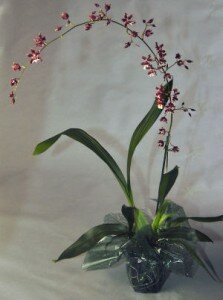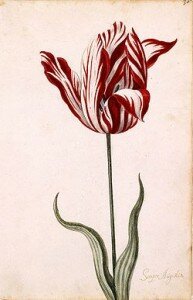Top 10 Most Bizarre and Exotic Flowers
Suggested by SMS
10. Blue Rose

Though the blue rose is certainly lovely and undoubtedly exotic, it barely makes this list because a true ‘blue’ rose doesn’t currently exist in nature. In the past, florists have been able to produce artificial blue roses by allowing naturally white roses to absorb blue dye, causing the petals to turn a royal blue or indigo color. However, in 2004, a team of Japanese scientists unraveled the riddle of rose genetics, figuring out how to “turn off” the rose gene that prevented the production of the blue pigment “delphinidin.” As a result, by incorporating iris and pansy genes into rose DNA, the team has been able to produce naturally-grown blue roses, which currently present with a distinctive lilac color. To date, the genetically-altered blue roses are rather pricey, being marketed to the lucrative cut flower industry.
9. Sherry Baby Orchid

Jasmine. Roses. Lillacs. These flowers have become beloved around the globe over for their fragrant scents, which form the basis for perfumes the world over. While the Sherry Baby’s scent will probably never be mass-distributed as a perfume, its aroma is no less beloved. This orchid, which sports brick-red blooms and whose growth is restricted only by the amount of space it is afforded, smells strikingly like chocolate. With fragrances said to range from mint-chocolate to vanilla-chocolate, the Sherry Baby has become extremely popular as a houseplant in recent years, due largely to the fact that it’s one of the easiest orchids for casual collectors to cultivate. Unlike other orchids, who have a reputation for being extremely finicky in cultivations, the Sherry Baby requires only a weekly watering and a sunny window to thrive.
8. The African Starfish (Stepelia gigantea)

You might think a flower that looks and smells like flatulence or decomposing flesh doesn’t deserve to be called “a flower” at all, unless you’re a carrion beetle or flesh-eating fly. The African Starfish, which grows in Southern Africa and sometimes in California, is approximately 8-10 inches high, with a sickening stench that either evokes rotting flesh or feces. A bright pink color with tiny white hairs that are meant to simulate mold growing on deceased animal flesh, the African Starfish attracts feces and flesh-loving insects.
7. The Bladder Campion (Silene vulgaris or Silene cucubalus)

Far less nauseating than the African Starfish is the delicate Bladder Campion, which is found growing wild along roadsides and in fields in the American Midwest. The Bladder Campion or “bladder flower,” as it is sometimes called, reaches between 8 and 24 inches in height and is easily recognizable because of its balloon-like calyx and pale green or white flowers. The Bladder Campion is believed to have as many as 10 stamens and 3 styles, as well as dark green or red veins on the calyx itself. Though the flowers only bloom for a month or so, the distinctive bladder of the plant can last for nearly an entire growing season.
6. Viceroy Tulip

At first glance, the Viceroy looks like any other tulip growing in a city parkway or someone’s garden. But it’s the story behind the Viceroy that makes it one of the world’s most exotic flowers. Though usually identified with Holland, tulips are believed to have originated in modern-day Turkey. In 1593, a Dutch botanist named Carolus Clusius brought several bulbs to Holland from Constantinople in order to establish a medicinal garden. His neighbors, aggravated by Clusius’ aversion to selling the exitic-looking flowers, broke into his garden and stole his bulbs. By the 1630s, tulips had become a status symbol of the rich in Holland, fetching astronomical prices at auction. In 1636, the bulbs of the Viceroy tulip, a marbled crimson and white flower, was sold at auction for the equivalent of $1250 in today’s US currency. Quite a feat, considering that the average Dutch worker earned approximately one-fourth of that price in an entire year. By 1637, the tulip bubble had burst, and the once-coveted flowers were worth only one-one hundredth of their original prices.
5. Bleeding Heart (Dicentra)

Native to Asia and North America, dainty Bleeding Heart takes almost two years to completely mature, eventually measuring 2-3 feet long. It’s one-inch, heart-shaped petals bloom in the spring and come in a variety of different colors, including rose pink, red, and white. These perennials are hardier than they look, and some species can maintain their blooms for an entire summer. As Bleeding Hearts’ vivid colors and unusual blooms are especially striking against a wooded background, they have become the favorites of casual gardeners in woodland borders all across the world.
4. Ghost Orchid

Famous for its central roles in both Susan Orlean’s book “The Orchid Thief and Charlie Kaufman’s movie Adaptation, the rare ghost orchid bears the distinction of having millions of fans who have probably never actually seen their favorite flower in real life. Native to Cuba and the Florida Everglades, the Ghost Orchid blooms from an epiphyte, a tangled mass of stems that wrap around a tree trunk. Also known as the “palm polly” or the “white frog orchid,” the Ghost Orchid was discovered by Jean Jules Linden in Cuba in 1844. Since then, it has proven extremely difficult to cultivate, being happiest growing 6 feet up or higher on pond-apple trees. Due to its unusual shape, the Ghost Orchid is pollinated solely by the giant sphinx moth, the only insect with a long enough proboscis.
3. Living Stone Plants (Lithops Optica)

At first glance, it’s difficult to even see this flower without its bloom, so adept is the living stone plant at blending in with the pebbles in its surroundings. The plant consists of a two-lobed, conical body, made up of two fused and thickened leaves. The short stem in between the two leaves is generally not visible. When the Living Stone Plant, generally found in West, South, and Central Africa, flowers, the bright white or yellow daisy-like bloom erupts from the tight fissure joining the two leaves together. The seeds inside the flower are wholly contained within a 4-8 chambered fruiting capsule.
2. Parrot Flower (Impatiens psittacina)

So exotic and rare is this flower, there was substantial debate about whether it was its own species or some unknown species of orchid. Discovered in 1899 in Burma, the Parrot Flower was identified at the Royal Gardens at Kew in London in 1901. Believed to grow only in Burma and Northern Thailand, the fragile bloom has been extremely difficult to cultivate, probably due to the fact that its odd shape requires that it have a local natural pollinator to procreate.
1. Titan Arum (Amorphophallus titanium)

Related to the popular calla lily, the Titan Arum is one flower no bride would want at her wedding, and not just because of its size. With its unbranched inflorescence (the central structure upon which the flower is arranged) reaching up to 10 feet tall, the Titan Arum is one of the largest “flowers” in the world. But the Titan Arum’s notoriety comes not from its gigantic size, but because of its nauseating stench. Known around the world as the “corpse flower,” the Titan Arum exists in many botanical gardens, but grows naturally only on the edges of rainforests, near grasslands, in its native Sumatra. The plant, discovered in 1878 by Odardo Beccari, flowers rarely in nature and even more rarely in cultivation. Its unique smell, which resembles that of a rotting human corpse, is believed to act in conjunction with the Arum’s bright red color to attract insects that would normally feed on decomposing mammal carcasses. Interestingly, the plant’s temperature hovers around that of a human body, which is thought to help the scent travel further. The plant was christened “Titan Arum” by BBC television narrator and naturalist Sir David Attenborough during his narration of “The Life of Plants,” as he thought repeatedly saying the word “amorphophallus” was inappropriate for his audience. The Ghost Orchid is currently protected under both Florida state and federal law; wild Ghost Orchids cannot be removed from their native soil.










The ghost orchid photo you have featured is the Cayman Islands Ghost (Dendrophylax fawcettii). Photos of the Florida Ghost Orchid (Dendrophylax lindenii) can be seen here:
The Ghost Orchid Page
Prem is correct – pictures may also be found at http://www.dkchristi.com Also, Susan Orleans never saw a ghost orchid though she wrote about them. D.K.Christi stalked the Florida Ghost ORchid at Corkscrew swamp for three years, three months each year and was inspired to write the novel, Ghost Orchid, in which NPR wrote, "The ghost orchid is the heart and soul of the story" and the beauty of the Everglades shines through every page. The ghost orchid's ethereal beauty has many photographers who capture it well, especially the beautiful orchid plant at Corkscrew Sanctuary in Naples, FL.
This blog is definitely rather helpful as I’m at the moment creating an on-line floral website – although I am only starting out therefore it is even now really small, nothing like this site. Could I link to some of the blogposts because they’re very interesting. Thanks. Samantha Cooper
I ABSOLUTLY Love the Bleeding Heart. Although, i think it should have a different name, it is beautiful !